Homemade Lasagna

Disclosure: This post may contain affiliate links. As an Amazon Associate, Satisfy Your Cravings earns from qualifying purchases. We may also participate in additional affiliate programs, accept sponsorships, or use other monetization methods throughout our site.
These partnerships help support our content and keep our recipes free for our amazing readers. We only recommend products and brands we personally use and trust in our own kitchen. Thank you for supporting us! 💛
The Ultimate Homemade Lasagna Recipe: A Comfort Food Classic
Lasagna is more than just a dish—it’s a symbol of love, warmth, and togetherness. There’s something magical about the way layers of tender pasta, rich meat sauce, and creamy cheeses come together to create a meal that feels like a hug on a plate. Whether you’re hosting a family gathering, preparing a comforting dinner for your loved ones, or simply indulging in a bit of self-care with a hearty homemade meal, lasagna always hits the spot. It’s a dish that never fails to impress and is just as enjoyable to make as it is to eat.
In this recipe, we’ll walk you through each step to make the ultimate homemade lasagna that’s both easy and delicious. From a flavorful meat sauce simmered to perfection to the creamy ricotta mixture that ties it all together, every layer is packed with love and flavor. So grab your apron, turn up some music, and get ready to create a dish that will quickly become a favorite at your table. Let’s make some lasagna magic!
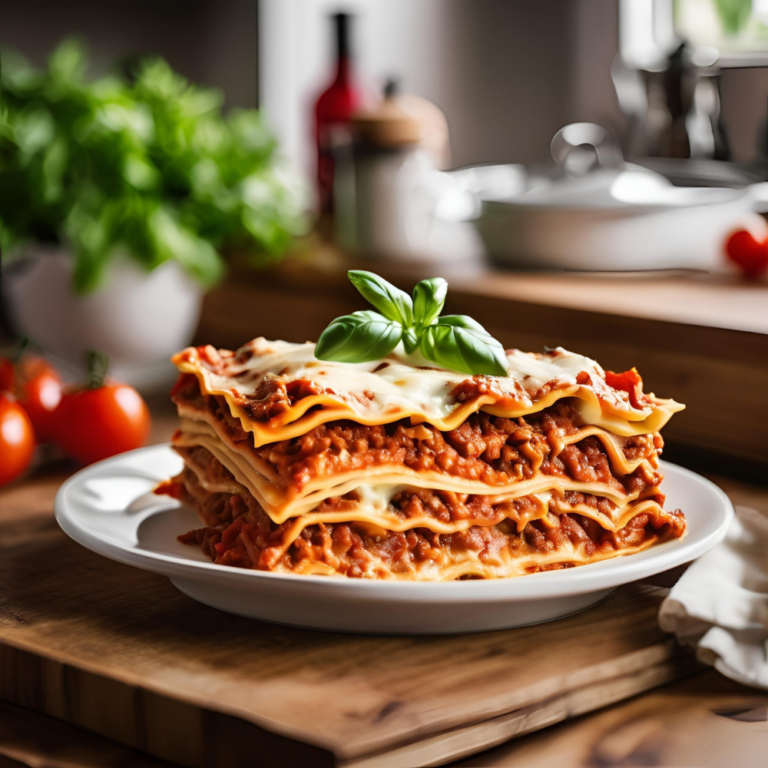
Nutrition Breakdown: Making Your Lasagna Healthier
Homemade lasagna is a hearty and indulgent dish, but it can also be tailored to fit your dietary goals. Here’s a general nutritional breakdown for one serving of traditional homemade lasagna (based on a recipe that serves 8):
Estimated Nutrition Per Serving:
- Calories: 450–550 (depending on portion size and ingredients)
- Protein: 25–30g
- Fat: 18–25g
- Carbohydrates: 40–50g
- Fiber: 4–6g
- Sugar: 7–10g
- Sodium: 800–1000mg
This breakdown varies depending on the specific ingredients and portion sizes you use. For example, using leaner meats, low-fat cheeses, or whole-grain noodles can significantly impact these numbers.
Tips for Making a Healthier Lasagna
- Use Whole-Grain or Vegetable Noodles: Swap traditional pasta for whole-grain lasagna sheets to increase fiber and nutrients, or opt for thin slices of zucchini or eggplant for a low-carb option.
- Choose Lean Meats: Use ground turkey or chicken instead of beef or pork to reduce saturated fat. You can also mix half ground meat with cooked lentils for added fiber and reduced fat.
- Lighten the Cheese: Opt for part-skim mozzarella and ricotta, or reduce the overall amount of cheese used. A little Parmesan goes a long way for flavor!
- Add More Veggies: Bulk up your lasagna with layers of vegetables like spinach, mushrooms, bell peppers, or shredded carrots. This adds vitamins, minerals, and fiber without extra calories.
- Go Easy on the Salt: Use herbs and spices like garlic, oregano, basil, and red pepper flakes to enhance flavor without overloading on sodium.
- Homemade Sauce: Store-bought sauces can be high in sugar and sodium. Making your own tomato sauce with fresh or canned tomatoes, garlic, and Italian seasonings gives you full control over the ingredients.
By making small adjustments to your lasagna recipe, you can enjoy a delicious, comforting meal that aligns with your health goals. Whether you’re looking to cut calories, boost protein, or sneak in more vegetables, lasagna can be as versatile as it is satisfying. Let us know in the comments how you customize your lasagna for a healthier spin!
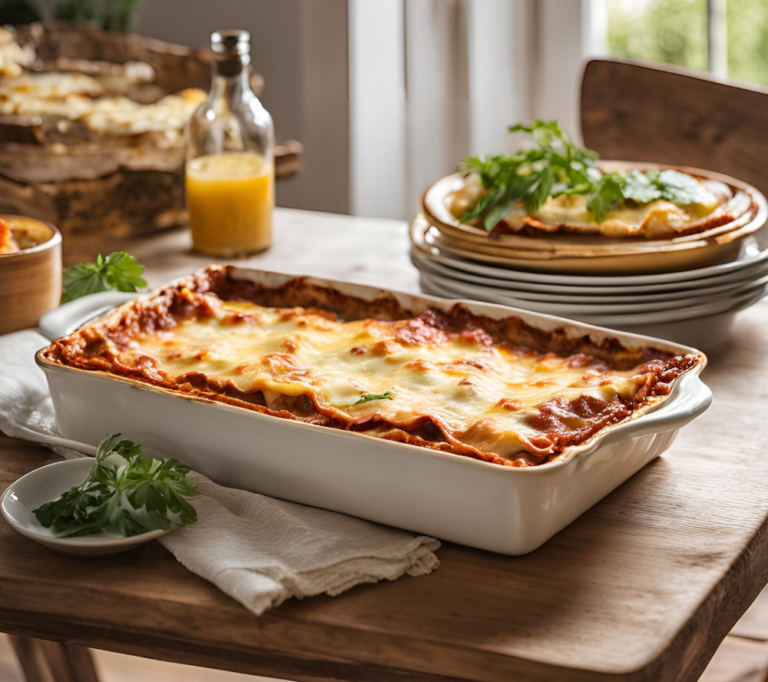
How to Make Homemade Lasagna Completely from Scratch
If you’re ready to take your lasagna game to the next level, why not make it entirely from scratch? Crafting your own pasta, sauce, and ricotta cheese may take a bit more time, but the results are truly rewarding. Here’s a step-by-step guide to creating homemade lasagna from scratch:

Homemade Pasta Sheets
Ingredients
Equipment
Method
- On a clean surface, create a mound with the flour and make a well in the center.
- Crack the eggs into the well and sprinkle in the salt. Add olive oil if using.
- Use a fork to gently whisk the eggs, gradually incorporating flour from the edges of the well.
- Once combined, knead the dough for 8–10 minutes until smooth and elastic. Wrap in plastic wrap and let rest for 30 minutes.
- Roll out the dough into thin sheets using a pasta machine or rolling pin. Cut into lasagna-sized strips and dust with flour to prevent sticking.
Notes
Make Ahead and Storage for Homemade Pasta Sheets
Make Ahead Tips
Homemade pasta sheets are a fantastic option for preparing ahead of time. Here’s how you can make your cooking process easier:- Refrigeration: After rolling and cutting the pasta sheets, layer them with parchment paper or dust them with flour to prevent sticking. Store them in an airtight container or resealable bag in the refrigerator for up to 2 days.
- Freezing: For longer storage, freeze the uncooked pasta sheets. Lay them flat on a baking sheet and freeze until solid, then transfer to a freezer-safe bag or container. They can be frozen for up to 2 months. Cook them straight from frozen or thaw in the refrigerator before use.
- Partially Cooked: If you prefer, blanch the pasta sheets in boiling water for 1 minute, then cool them in ice water. Pat dry and store in an airtight container in the fridge for up to 2 days.
Storage Tips
Proper storage ensures your homemade pasta sheets remain fresh and ready to use:- Cooked Pasta Sheets: If you’ve cooked the sheets and have leftovers, layer them with parchment paper or drizzle with a bit of olive oil to prevent sticking. Store in an airtight container in the refrigerator for up to 3 days.
- Reheating: To soften refrigerated or frozen pasta sheets before use, you can quickly dip them in boiling water for 30 seconds.
- Drying: If you want to store the pasta long-term at room temperature, let the sheets dry completely on a clean surface or pasta drying rack until brittle. Store in an airtight container in a cool, dry place for up to 2 weeks.

Homemade Marinara Sauce
Ingredients
Equipment
Method
- Heat olive oil in a large saucepan over medium heat. Sauté the onion until soft, about 5 minutes. Add the garlic and cook for 1 minute.
- Crush the canned tomatoes by hand and add them to the pan along with the juices.
- Stir in sugar, basil, oregano, salt, and pepper. Simmer uncovered for 20–30 minutes, stirring occasionally.
- Blend the sauce for a smoother texture or leave it chunky for a rustic feel.
Notes
Make Ahead and Storage for Homemade Marinara Sauce
Make Ahead Tips
Homemade marinara sauce is perfect for making ahead, as the flavors deepen and improve over time. Here’s how you can prepare and store it in advance:- Refrigeration: After cooking, let the sauce cool completely. Store it in an airtight container in the refrigerator for up to 5 days.
- Freezing: For longer storage, divide the sauce into portion-sized containers or freezer bags, leaving a little space for expansion. Freeze for up to 3 months. Thaw in the refrigerator overnight before reheating.
Storage Tips
Proper storage ensures your marinara sauce stays fresh and flavorful:- Reheating: Reheat the sauce on the stovetop over low heat, stirring occasionally, until warmed through. Add a splash of water or broth if it has thickened too much.
- Portioning: Freeze the sauce in ice cube trays for small portions, perfect for quick meals or single servings. Once frozen, transfer the cubes to a freezer bag.
- Canning (Optional): If you’re experienced with canning, you can preserve the marinara sauce in sterilized jars using a water bath canning method. This allows you to store it at room temperature for several months.

Homemade Ricotta Cheese
Ingredients
Equipment
Method
- Heat milk, cream, and salt in a large pot over medium heat until it reaches 185°F (just below boiling). Stir occasionally to prevent scorching.
- Remove from heat and stir in lemon juice or vinegar. Let sit for 5–10 minutes until curds form.
- Line a colander with cheesecloth and pour the mixture through to separate the curds from the whey. Let drain for 10–20 minutes, depending on your desired consistency.
- Transfer ricotta to a container and refrigerate until ready to use.
Notes
Make Ahead and Storage for Homemade Ricotta Cheese
Make Ahead Tips
Homemade ricotta cheese is an excellent option to prepare ahead of time. It stays fresh and versatile for various recipes:- Refrigeration: Once made, allow the ricotta to cool completely and transfer it to an airtight container. Refrigerate for up to 5 days.
- Freezing: For longer storage, portion the ricotta into airtight containers or freezer bags. Freeze for up to 2 months. Thaw overnight in the refrigerator before use and stir well to restore its creamy texture.
Storage Tips
Proper storage ensures your homemade ricotta remains fresh and ready to use:- Moisture Control: Keep the ricotta well-drained by using a clean, dry container. Excess liquid can affect its texture over time.
- Freezing Tips: If freezing, use smaller portions to make thawing more convenient for recipes like lasagna or spreads.
- Texture Maintenance: After thawing, if the texture feels grainy, whisk the ricotta gently to restore its smooth consistency.
Assembling Your Made-From-Scratch Lasagna
Once you’ve prepared all your components, assemble and bake your lasagna as outlined in the main recipe. With every layer crafted by hand, your lasagna will be bursting with freshness and flavor that store-bought ingredients simply can’t match.
Making lasagna from scratch is a labor of love, but the process is as rewarding as the result. It’s perfect for special occasions or when you want to wow your family and friends. Let us know if you try this fully homemade version and share your experience!
Try some of our other recipes!
Spring Greens & Edamame Salad with Miso Dressing
Clean Cuisine / Dinner Delicacies 99
0
Spanish-Inspired Chickpea Paella
Dinner Delicacies 128
0
Herb-Roasted Lamb with Mashed Cauliflower
Dinner Delicacies 79
0
Spring Detox Salad with Lemon Vinaigrette
Clean Cuisine / Dinner Delicacies 146
0
Irish-Inspired Veggie Stew
Dinner Delicacies 77
0
Kid-Friendly Lasagna Hacks: Make It Fun and Easy for Little Eaters
Lasagna is already a family favorite, but with a few creative tweaks, you can make it even more appealing to kids. Here are some fun, simple hacks to ensure your little ones clean their plates and ask for seconds:
1. Use Fun Shapes
Swap traditional lasagna noodles for fun pasta shapes like bow ties, wagon wheels, or mini shells. Kids love playful textures and shapes that make their meal exciting.
Try making individual portions using muffin tins or small ramekins for a mini lasagna that’s perfectly kid-sized.
2. Sneak in Veggies
Blend spinach, carrots, or zucchini into the tomato sauce for an invisible veggie boost. Pureeing the vegetables ensures they won’t notice the extra nutrition.
Add layers of finely chopped or grated vegetables between the pasta sheets for extra vitamins and fiber.
3. Let Them Customize
Create a “build-your-own-lasagna” station where kids can choose their layers. Set out options like shredded cheese, pepperoni slices, or small veggie pieces, and let them assemble their mini lasagnas.
4. Keep It Mild
Use mild Italian sausage or ground turkey instead of spicy meats to keep flavors kid-friendly.
Avoid strong herbs or spices that might be overwhelming, focusing instead on simple, classic flavors.
5. Add a Cheesy Twist
Double up on the cheese! Most kids can’t resist gooey, melty mozzarella. Add a layer of their favorite cheese, like cheddar or Colby Jack, for an extra creamy lasagna.
6. Make It Bite-Sized
Roll up cooked lasagna noodles with fillings (cheese, sauce, and meat or veggies) and bake them as lasagna roll-ups. These handheld portions are perfect for little fingers.
7. Add a Familiar Twist
Swap the tomato sauce for a creamy Alfredo or cheese sauce to cater to kids who prefer white sauces.
Add kid-friendly toppings like small meatballs, pepperoni, or even a sprinkle of crumbled bacon.
8. Serve It With a Side of Fun
Pair lasagna with a fun side dish, like cheesy garlic breadsticks or a colorful fruit salad. A creative presentation can make the whole meal more exciting.
Use cookie cutters to shape any leftover noodles into stars, hearts, or other fun designs and add them as a garnish on top.
9. Make It Sweet
For dessert, create a sweet lasagna with layers of graham crackers, pudding, whipped cream, and fruit. This twist will have kids asking for lasagna at every meal!
With these kid-friendly hacks, lasagna becomes more than just dinner—it’s an activity, a treat, and a meal they’ll love. Try these ideas, and let us know which ones were a hit at your table!
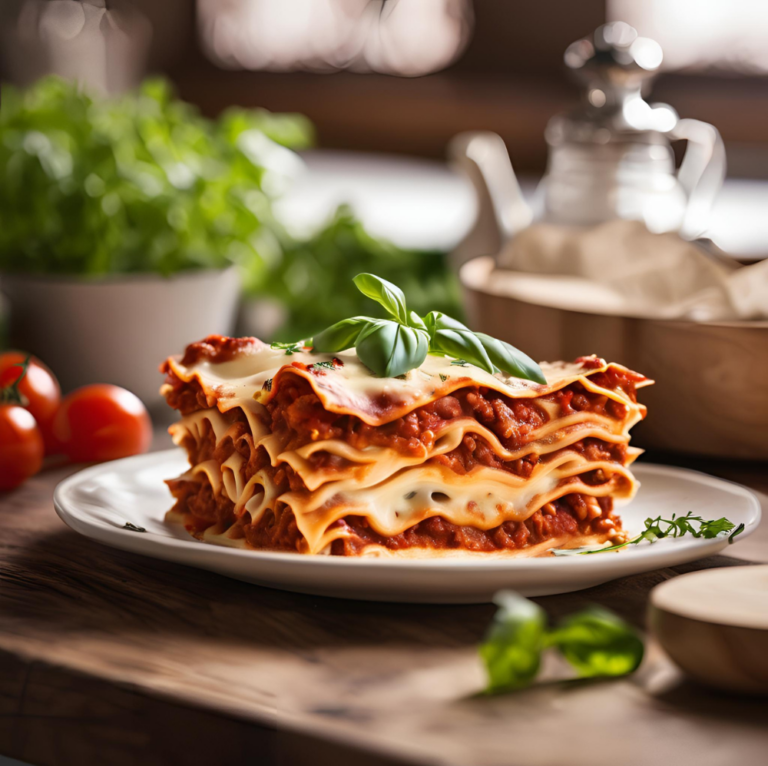
Lasagna Around the World: Unique Takes on a Classic Dish
Lasagna may have originated in Italy, but its influence has spread across the globe, inspiring creative interpretations in various cuisines. From spicy, layered casseroles to noodle-free adaptations, here’s a look at how lasagna is reimagined worldwide:
1. Italian Classic: Lasagna Bolognese
- Origin: Italy
- The traditional Italian lasagna features layers of fresh pasta, slow-cooked Bolognese sauce made with beef, pork, and tomatoes, creamy béchamel sauce, and Parmesan cheese. It’s a hearty, rich dish that embodies the essence of Italian cuisine.
2. Mexican Lasagna
- Origin: Mexico/United States
- A flavorful twist replaces pasta sheets with tortillas and layers of seasoned ground beef, black beans, salsa, and cheese. It’s often topped with sour cream, guacamole, and fresh cilantro for a vibrant finish.
3. Greek Lasagna: Pastitsio
- Origin: Greece
- This Greek version uses tubular pasta (like ziti) instead of flat noodles, layered with spiced ground beef (often flavored with cinnamon and nutmeg) and topped with a creamy béchamel sauce. It’s baked to golden perfection and served as a family favorite.
4. Middle Eastern Lasagna
- Origin: Middle East
- Thin sheets of flatbread, like lavash, are used instead of pasta, layered with spiced ground lamb, eggplant, and a yogurt-based sauce. This version often features bold spices like cumin, coriander, and sumac.
5. Indian Lasagna
- Origin: India
- Indian-inspired lasagna replaces traditional pasta with layers of roti or naan bread and includes fillings like spiced lentils, paneer (Indian cheese), and a tomato-based curry sauce. It’s a flavorful fusion of Italian and Indian cuisines.
6. Filipino Lasagna
- Origin: Philippines
- In this sweeter variation, the meat sauce includes banana ketchup and sugar for a unique taste. It’s layered with lasagna noodles, béchamel sauce, and a generous amount of cheese, reflecting Filipino comfort food traditions.
7. Vegan Lasagna
- Origin: Global
- A plant-based twist, this version uses vegetables like zucchini or eggplant slices in place of noodles and layers them with cashew cream, spinach, and a hearty tomato sauce. It’s a favorite among health-conscious and vegan eaters.
8. Japanese Lasagna
- Origin: Japan
- Often served in Japanese-American sushi restaurants, this “lasagna” features layers of sushi rice, crab, cream cheese, and Japanese mayo, baked until golden. It’s a fusion dish with a creamy, umami-packed flavor.
9. French Lasagna
- Origin: France
- French-inspired lasagna layers include crepes instead of pasta sheets, combined with rich béchamel sauce, sautéed mushrooms, spinach, and Gruyère cheese for a decadent meal.
10. South African Bobotie Lasagna
- Origin: South Africa
- Inspired by the traditional South African dish bobotie, this lasagna features layers of spiced minced meat, curry, and custard, blending sweet and savory flavors in a unique way.
11. Caribbean Plantain Lasagna
- Origin: Caribbean
- In this tropical take, sweet plantain slices replace pasta sheets, layered with ground beef, tomato sauce, and cheese. It’s a sweet-and-savory delight popular in countries like Puerto Rico and the Dominican Republic.
12. Swedish Lasagna
- Origin: Sweden
- Known as “våffel-lasagne,” this playful version replaces pasta sheets with Swedish waffles, layered with creamy meat sauce and béchamel for a fun twist on the classic dish.
Lasagna’s adaptability proves that it’s not just a dish—it’s a concept that transcends borders. Each variation tells a story of cultural flavors and culinary creativity. Have you tried a unique lasagna from around the world? Share your favorite versions in the comments below!
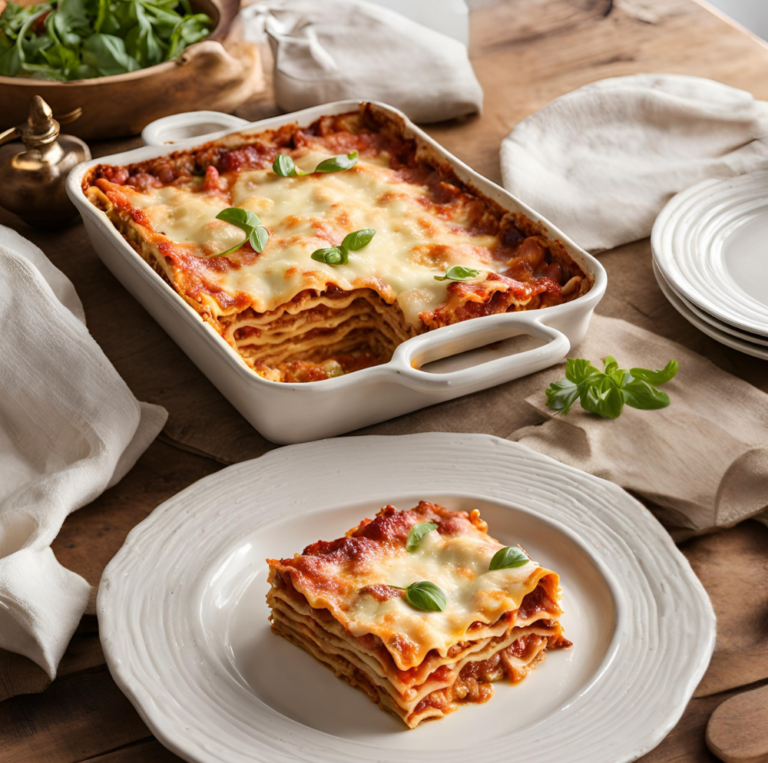
Make-Ahead Lasagna: A Meal Prep Favorite
Lasagna isn’t just a comforting family dinner; it’s also a meal prep hero! With its layered structure and ability to hold up well in the fridge or freezer, lasagna can be your go-to solution for busy weeknights or pre-planned gatherings. Here’s how to turn lasagna into a meal prep star:
1. Assemble and Store
- Refrigeration: Prepare your lasagna ahead of time by assembling it fully, but don’t bake it yet. Cover tightly with plastic wrap or foil and store it in the refrigerator for up to 2 days. When ready to cook, simply pop it in the oven, adding 10–15 extra minutes to the baking time.
- Freezing: For longer storage, assemble the lasagna, wrap it tightly with a layer of plastic wrap and foil, and freeze it for up to 3 months. To bake, thaw it overnight in the fridge or bake directly from frozen, adding about 30 minutes to the cooking time.
2. Portion Control
- If you’re cooking for one or two, consider preparing mini lasagnas in ramekins or individual foil pans. This way, you can bake only what you need and freeze the rest for another day.
3. Layer Your Way to Variety
- Meal prepping doesn’t have to mean eating the same thing every night! Create different versions in one batch—add vegetables to one half, extra meat to another, or even a white sauce layer in a smaller portion for variety.
4. Pre-Cut for Convenience
- After baking, let your lasagna cool completely and cut it into single-serving portions. Wrap each portion individually in foil or place them in airtight containers. These grab-and-go servings are perfect for quick lunches or dinners.
5. Reheating Tips
- Oven: Reheat individual portions in the oven at 350°F (175°C) for 20–25 minutes, covered with foil to prevent drying out.
- Microwave: For a faster option, heat a single portion in the microwave for 3–5 minutes, adding a splash of water or sauce to keep it moist.
6. Double Batch, Double Reward
- When meal prepping, always make a double batch! Bake one for now and freeze the other for later. This strategy saves time and ensures you always have a ready-made meal waiting for you.
7. Pair It Up
- Prep complementary side dishes, like garlic bread or a simple salad, ahead of time to create a complete meal with minimal effort.
By planning and prepping your lasagna ahead of time, you’ll have a delicious, hearty meal ready whenever you need it. It’s the perfect dish to simplify your week while keeping everyone satisfied! Let us know your favorite lasagna meal prep tricks in the comments below.
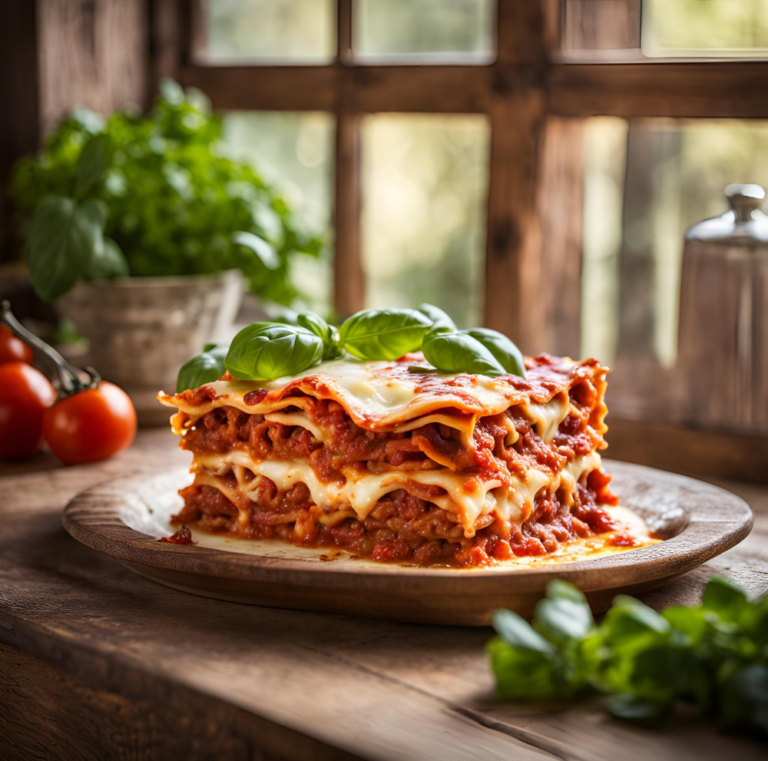
Lasagna Your Way: Unique Recipes to Suit Every Taste
One of the best things about lasagna is its versatility. With a few simple swaps or additions, you can create a version tailored to your tastes or dietary needs. Here are some ideas to inspire your next lasagna creation:
1. Vegetarian Lasagna
Skip the meat and pile on the veggies! Replace the ground beef and sausage with sautéed vegetables like spinach, zucchini, mushrooms, bell peppers, and carrots. For an extra boost of flavor, roast the vegetables beforehand to caramelize their natural sweetness. You can also add a layer of cooked lentils or chickpeas for added protein.
2. Gluten-Free Lasagna
For a gluten-free option, use gluten-free lasagna noodles available at most grocery stores. Alternatively, swap the noodles for thin slices of zucchini, eggplant, or sweet potato. These vegetable layers not only eliminate gluten but also add a unique flavor and texture to your dish.
3. Cheesy Lasagna
If you’re a cheese lover, go all out by incorporating additional cheeses. Try provolone, asiago, or fontina for extra creaminess and depth. You can also mix shredded cheese directly into the ricotta mixture for an even cheesier bite.
4. White Lasagna
Switch things up with a white lasagna! Replace the tomato-based meat sauce with a creamy Alfredo sauce. Use cooked chicken or turkey as the protein, and consider adding fresh spinach or artichoke hearts for a flavorful twist.
5. Seafood Lasagna
For a coastal twist, use a mix of seafood such as shrimp, crab, and scallops. Pair these with a creamy Alfredo or béchamel sauce instead of the traditional tomato base. A sprinkle of fresh dill or parsley adds a refreshing finish.
6. Low-Carb Lasagna
Skip the pasta entirely and use layers of grilled zucchini, eggplant, or spaghetti squash instead. You can also make a “lasagna bake” by layering the filling and sauce without noodles at all, creating a keto-friendly version.
7. Spicy Lasagna
If you enjoy a little heat, add spicy Italian sausage to your meat sauce or mix in a teaspoon of red chili flakes. For an extra kick, drizzle some hot sauce between the layers or use pepper jack cheese for a spicy cheesy layer.
8. Vegan Lasagna
Make this classic completely plant-based by using vegan cheese alternatives and tofu or cashew cream in place of ricotta. For the meat sauce, use lentils, crumbled tofu, or a plant-based ground beef substitute. Add layers of roasted vegetables for even more flavor and texture.
9. Mediterranean Lasagna
Bring Mediterranean flavors into your lasagna with layers of roasted red peppers, olives, artichokes, and feta cheese. Use a marinara sauce with hints of oregano and garlic to tie everything together.
10. Breakfast Lasagna
Why not enjoy lasagna for breakfast? Replace the noodles with sheets of cooked hash browns, use scrambled eggs as one of the layers, and add crumbled breakfast sausage or bacon. Use a creamy cheese sauce to bring it all together for a hearty morning treat.
11. Dessert Lasagna
Yes, lasagna can even be sweet! Create a dessert version with layers of sweetened ricotta or mascarpone, graham crackers or cookies, and your favorite fruits or chocolate ganache. A final sprinkle of powdered sugar or drizzle of caramel sauce makes it irresistible.
12. International Flavors
- Mexican Lasagna: Swap the noodles for tortillas and use seasoned ground beef or shredded chicken, black beans, salsa, and a mix of cheddar and Monterey jack cheese. Add a dollop of sour cream and guacamole on top before serving.
- Greek Lasagna (Pastitsio): Use penne or ziti noodles in place of lasagna sheets, layer with a spiced ground beef sauce flavored with cinnamon and nutmeg, and top with a creamy béchamel sauce.
13. Mini or Single-Serving Lasagna
Make individual portions by assembling your lasagna in ramekins or a muffin tin. These mini lasagnas are perfect for meal prep, dinner parties, or as freezer-friendly options for quick weeknight meals.
14. Extra Protein Lasagna
Boost the protein content by adding cooked and crumbled bacon, diced chicken breast, or extra layers of cheese. You can also mix cottage cheese into the ricotta for an additional protein kick.
15. Kid-Friendly Lasagna
Make lasagna more appealing to kids by using bite-sized pasta like bow ties or penne in place of lasagna sheets. Let them pick their favorite vegetables or add a hidden layer of blended veggies for extra nutrition.
16. Holiday Lasagna
Give your lasagna a seasonal twist. For fall, add roasted butternut squash or pumpkin puree to the ricotta mixture. During the summer, incorporate fresh basil pesto between the layers for a burst of vibrant flavor.
No matter how you choose to customize your lasagna, it’s a dish that’s as versatile as it is delicious. Get creative, mix and match flavors, and make it your own!
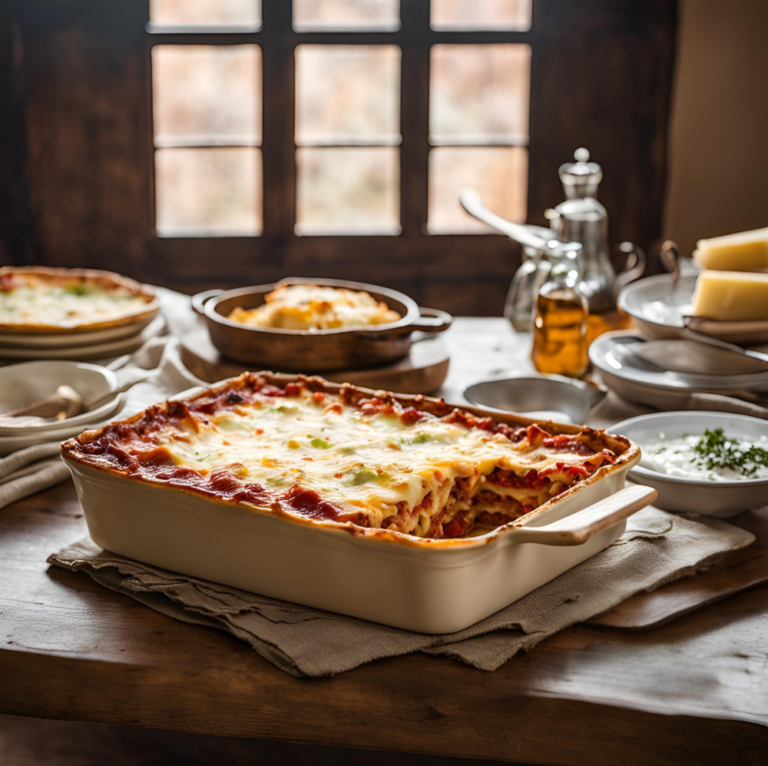
Disclosure: This post may contain affiliate links. As an Amazon Associate, Satisfy Your Cravings earns from qualifying purchases. We may also participate in additional affiliate programs, accept sponsorships, or use other monetization methods throughout our site.
These partnerships help support our content and keep our recipes free for our amazing readers. We only recommend products and brands we personally use and trust in our own kitchen. Thank you for supporting us! 💛
🛍️ Shop the Recipe
Make your lasagna night legendary with the right tools and high-quality ingredients 🧀🍅 Whether you’re layering up a Sunday dinner for the family or prepping for a cozy night in, here are my favorite kitchen must-haves that make this homemade lasagna recipe easy, delicious, and satisfying every time!
As an Amazon Associate, I earn from qualifying purchases. Thank you for supporting Satisfy Your Cravings — your support means the world and helps us keep sharing your favorite feel-good meals! 💛
✅ Deep 9×13 Glass Baking Dish with Lid – Perfect for Lasagna Layers
✅ Nonstick Saucepan – Ideal for Simmering Tomato Sauce
✅ Cheese Grater – For Fresh Mozzarella, Parmesan, & More 🧀
✅ No-Boil Lasagna Noodles – Quick & Easy
✅ Organic Crushed Tomatoes – For a Rich, Clean Sauce
✅ Storage Containers – Freeze or Store Leftovers Easily
💡 Clean Comfort Food Tip: Use no-boil lasagna noodles to cut down on prep time, and opt for organic crushed tomatoes to build a rich, preservative-free sauce. Want to go dairy-light? Try part-skim mozzarella or a dairy-free alternative!
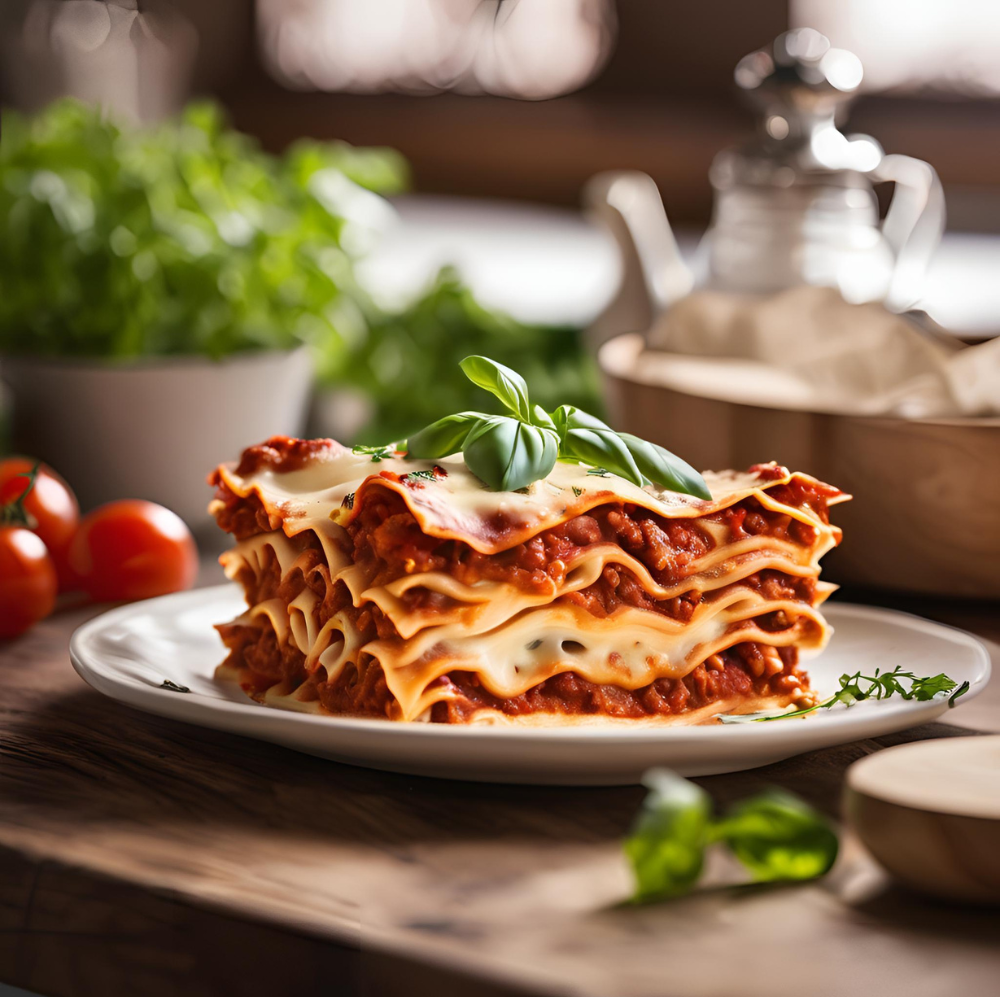
Homemade Lasagna
Ingredients
Equipment
Method
- Preheat your oven to 375°F (190°C).
- In a large skillet, cook the ground beef over medium heat until browned, breaking it up with a spoon as it cooks.
- Add the chopped onion and minced garlic to the skillet and cook until softened, about 5 minutes.
- Stir in the crushed tomatoes, tomato paste, dried oregano, and dried basil. Season with salt and pepper to taste. Let the sauce simmer for 10-15 minutes, allowing the flavors to meld together.
- In a separate bowl, combine the ricotta cheese and egg until well mixed.
- To assemble the lasagna, spread a thin layer of the meat sauce in the bottom of a 9x13-inch baking dish. Arrange a layer of cooked lasagna noodles on top, followed by a layer of the ricotta mixture and a sprinkle of mozzarella cheese. Repeat the layers until all ingredients are used up, finishing with a layer of meat sauce on top.
- Sprinkle the grated Parmesan cheese evenly over the top of the lasagna.
- Cover the baking dish with aluminum foil and bake in the preheated oven for 30 minutes.
- Remove the foil and continue baking for an additional 15 minutes, or until the cheese is bubbly and golden brown.
- Let the lasagna cool for a few minutes before slicing and serving. Garnish with fresh basil leaves if desired.
Notes
Make Ahead and Storage for Homemade Lasagna
Make Ahead Tips
Homemade lasagna is perfect for making ahead, whether you’re preparing for a busy weeknight or hosting a dinner party. Here’s how:- Assemble Ahead: Fully assemble the lasagna but do not bake it. Cover tightly with plastic wrap and aluminum foil, then refrigerate for up to 2 days. When ready to cook, simply bake as directed, adding an extra 10–15 minutes to the cooking time.
- Freeze for Later: To freeze, assemble the lasagna in a freezer-safe baking dish. Wrap it tightly with plastic wrap and foil to prevent freezer burn. Freeze for up to 3 months. Thaw overnight in the refrigerator before baking or bake directly from frozen, adding an additional 30–40 minutes to the baking time.
Storage Tips
Proper storage ensures your lasagna stays fresh and delicious for leftovers:- Refrigeration: Store leftover baked lasagna in an airtight container in the refrigerator for up to 5 days. Reheat individual portions in the microwave or oven.
- Freezing Leftovers: Freeze individual slices in airtight containers or wrapped tightly in foil for up to 3 months. This makes it easy to reheat single servings when needed.
- Reheating Tips: To reheat in the oven, cover the lasagna with foil and bake at 350°F (175°C) for 20–25 minutes until heated through. For quicker reheating, microwave individual portions for 2–3 minutes, adding a splash of water or sauce to keep it moist.
Green Goddess Vodka Spritz Cocktail
Sip & Savor Drinkable Delights For Every Ocassion 92
0
Emerald Isle Gin Fizz Cocktail
Sip & Savor Drinkable Delights For Every Ocassion 97
0
Clover Club Lite Cocktail
Sip & Savor Drinkable Delights For Every Ocassion 93
0
Strawberry Basil Infused Water
Sip & Savor Drinkable Delights For Every Ocassion 79
0
Coconut Matcha Latte
Clean Cuisine / Sip & Savor Drinkable Delights For Every Ocassion / Sunny Side Up Breakfast Delights 193
1

Share Your Lasagna Creations: Join Our Foodie Community Today!
Homemade lasagna is more than just a recipe; it’s an experience that brings joy to both the cook and those lucky enough to enjoy it. Each layer tells a story of comfort and care, making it the perfect centerpiece for family dinners, celebrations, or a cozy night at home. With its rich flavors and satisfying textures, this lasagna is sure to become a favorite in your kitchen, one that’s requested again and again.
We’d love to hear how this recipe turns out for you! Did you try any variations, or do you have tips of your own to share? Leave a comment below and let me know. If you enjoyed this recipe, don’t forget to subscribe to Satisfy Your Cravings for more delicious ideas to inspire your cooking. Together, we can keep creating and sharing meals that bring people closer and satisfy every craving.
Join Now!
Love this lasagna recipe? Don’t stop here—discover even more comforting, flavorful, and easy-to-make dishes. By joining our email community, you’ll get access to exclusive content, bonus recipes, and tips to make cooking at home simple and enjoyable.
Enter your email below to subscribe and start receiving tasty inspiration right to your inbox. It only takes a minute to become part of our growing community of food lovers who are passionate about creating and sharing meals that satisfy every craving. Let’s make dinnertime special together!
Disclosure: This post may contain affiliate links. As an Amazon Associate, Satisfy Your Cravings earns from qualifying purchases. We may also participate in additional affiliate programs, accept sponsorships, or use other monetization methods throughout our site.
These partnerships help support our content and keep our recipes free for our amazing readers. We only recommend products and brands we personally use and trust in our own kitchen. Thank you for supporting us! 💛
